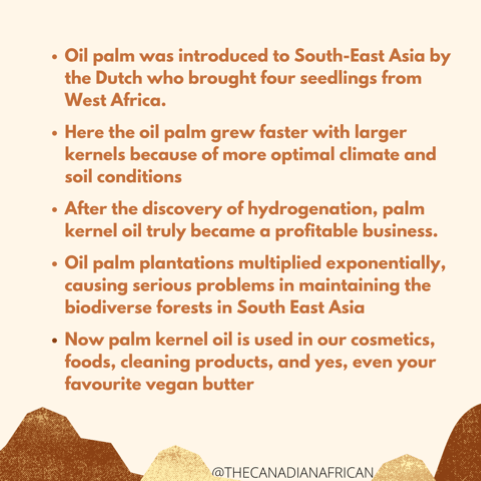Does the mention of palm oil make you think about deforestation, habitat destruction, and exploited workers? You’re not alone. You’ve likely heard that palm oil is unsustainable, but that’s not the whole story. We can help reduce its environmental impact by becoming informed, advocating for change, and choosing sustainably farmed palm oil.
Palm oil, an ingredient in 50% of packaged products, is in high demand. Yet despite its presence in so many goods we consume daily, many of us in the western world know little about its origins and uses. And the impacts of palm oil are often deeply misunderstood.
Is Palm Oil Unsustainable?
Palm oil is a versatile vegetable oil that originates from oil palms in western and southwestern Africa, where it still has a high cultural and culinary value. Africans in these regions have grown bright red-orange palm fruits using sustainable small-scale and low-waste methods for millennia.


Image courtesy of @thecanadianafrican
But the industrial-scale production of palm oil brought change. Logging for large palm plantations causes deforestation and biodiversity loss in the tropics. And the dark colonial history of conquest, war, and slavery in Africa has led to an industry that demands cheap labor and inflicts human rights violations on its workers.

Image courtesy of @thecanadianafrican
Is palm oil the culprit? After fielding skepticism from participants who saw red palm oil on the menu at her Immigrant Recipe Dinner series, Yewande Komolafe, a recipe developer and food stylist from Lagos, Nigeria, wanted to set the record straight. She writes, “Palm oil criticism is well-intentioned, but it is founded upon ignorance — ignorance of how colonial systems have evolved into our current global trade.”

Image courtesy of @thecanadianafrican
Palm oil is not inherently unsustainable. It’s our collective demand for palm oil that drives unsustainable harvesting and human rights practices.
Why Is Palm Oil in Such High Demand?
Palm oil is a natural cosmetic and food preservative. Refined, bleached, and deodorized, palm oil is also used widely in hygiene and beauty products as emollients, emulsifiers, and surfactants. Processed palm oil is a common ingredient in cosmetics, shampoos and soaps, toothpaste, deodorant, and laundry detergent.
It’s also a common ingredient in processed, packaged foods ranging from candy bars and potato chips to bread and instant noodles. After health advocates blacklisted trans fats, refined palm oil replaced them in many food products.
But how can you tell if the palm oil in the products you use is sustainable?
Concerns Over Sustainably Certified Palm Oil
In 2005, the Roundtable on Sustainable Palm Oil (RSPO) debuted its “certified sustainable palm oil” (CSPO) ecolabel. As of October 2020, it has certified nearly 4.5 million hectares of oil palms, corresponding to 19% of global palm oil produced. As of April 2020, the CSPO label appears on over 400 consumer products.
Greenpeace, however, flags RSPO efforts as misleading. Though RSPO purports all sources are traceable, the palm supply chain is complicated; even certified products can contain unsustainable palm oil. Though certification involves setting human rights and social standards, an AP investigation into Indonesian and Malaysian plantations revealed egregious labor abuses among certified plantations.

Just a few of the everyday products that contain palm oil
Should You Boycott Palm Oil?
Despite imperfect sustainability certification, boycotting is not the answer.
According to the Sumatran Orangutan Society, a boycott unequivocally would not help workers, forests, or orangutans. On the contrary, it could have unintended consequences, like increased demand for soybean or sunflower oils that require five to 10 times more land. Or it could depress palm oil prices, encouraging its use in biofuels and livestock feed — products whose ingredients receive less scrutiny from consumers.
In addition, about 4.5 million Indonesians and Malaysians currently earn a living from palm oil production. We know the industry is in need of fundamental change: The status quo fuels child labor, worker exploitation, and sexual abuse. Yet a wholesale boycott that could deprive workers of a primary source of income without recourse.
Elsewhere, palm oil can and is grown sustainably, as with the Seredipalm project that supports sustainable palm oil from smallholder farms in Ghana, most notably featured in Dr. Bronner’s products. Such models are small-scale by design and necessity, and can’t replace current demand.
As an individual consumer with few alternatives to unsustainable palm oil, it’s genuinely difficult to know what to do. But you can choose between “better” and “worse.”
Get Smart About Sustainable Palm Oil
1. Learn the many names of palm oil.
Although seeing “palm” in an ingredient list is a dead giveaway, labels often hide palm oil and its derivatives in plain sight.
- The acronyms PKO, PHPKO, FP(K)O, OPKO, all derivatives of palm kernel oil (which is made from the palm fruit kernel, not the fruit).
- Any ingredient with “palmitate” or “palmate” in it. This includes Vitamin A palmitate, which can be derived from other oils but is most likely to be palm oil.
- Glyceryl stearate, stearic acid, steareth-2, steareth-20
- Sodium laureth sulfate (SLES), sodium lauryl sulfate (SLS), common personal care product foaming agents.
Find a full list of potential ingredient names at the Orangutan Alliance. Some, like SLES/SLS, are sometimes also derived from coconut or Ricinus oils, but there is no way to tell from the label. If you want to check the origins of any particular ingredient, contact the brand directly.
2. Uncover how much palm oil you consume.
Do a home scavenger hunt to find palm oil in your kitchen, pantry, bedroom, and bathroom cupboards. Don’t forget to check candy, pet food, and personal care products. How many contain palm oil or derivatives generally? How many have the CSPO label or state they are palm-oil free?
3. Read ingredient lists.
Whether at the grocery store or pharmacy, get into the habit of skimming for ingredients you want to avoid — every time.
This way, you can use your consumer dollars to “vote” for sustainability as often as possible instead of passively supporting the status quo.
4. Push for change — in companies and certification.
Multinational brands like Nestlé, Unilever, and Colgate-Palmolive (where industrial demand for palm oil is reflected in the name), all have site pages dedicated to responsible palm oil sourcing, but Rainforest Rescue has found this is just a smokescreen.
Current RSPO certification is clearly not a solution, but it’s a start. Improving the monitoring process is the best compromise between preserving modern livelihoods (while agitating for better labor standards) and throwing the supply chain into disarray, which may worsen the environmental and human impact.
In the meantime, divert your own demand in favor of more sustainable ingredients and pressure companies to do better. Ask where they source their palm oil and if they can prove it doesn’t contribute to deforestation or human rights abuses.
Vet skin care products for sustainability. While palm oil alternatives are hard to find — for example, LUSH combines cocoa butter, olive oil, castor oil, and sodium hydroxide just to eliminate palm-derived SLS — researchers are investigating solutions. You can also learn how to make your own soap and other cosmetics.
Educate Yourself and Others, Gently
From plant-based milks to energy efficiency and everything in between, we are learning how to better live our green values all the time. Palm oil is just one of many nuanced, interconnected environmental issues. It presents a great opportunity to check where we may be falling short before we criticize others.
Consider people who drink bottled water because tap water is unsafe in their neighborhood, people who struggle to access local produce because they live in a food desert, or people who cook with palm oil because their communities harvest it sustainably.
Always inform yourself as best you can on the whole story, and then share your knowledge, sensitively, with others.
The post How Can We Reduce Our Demand for Unsustainable Palm Oil? appeared first on Earth 911.







